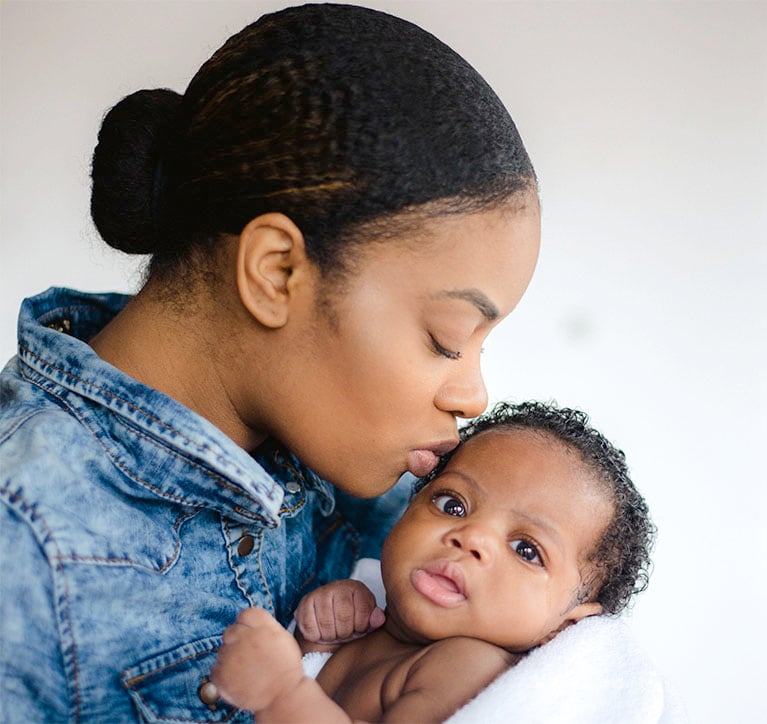What is Baby Acne? Treatment, and Causes
There’s nothing in the world as endearing as your baby’s delicate, sweet-smelling skin, and you’ll likely never tire of staring at them – which is why it’s important to learn about the common challenge of baby acne early on. When you discover these red bumps developing on baby’s skin, don’t panic and don’t pick. Baby’s skin is likely just adjusting to life on the outside.
What is Baby Acne?
Baby acne, also known as neonatal acne, is a skin condition that occurs during baby’s first few months of life, with a typical onset between two and four weeks of age. You’ll notice tiny red or white pimples on baby’s face, likely on their cheeks, or upper trunk. Baby acne on face and body typically resolves without treatment during the first few months of baby’s life and rarely leaves behind scars.
Is baby acne normal?
Up to 30 percent of babies develop baby acne, making it a pretty common challenge for baby – and baby’s caregivers - to face together. So, yes, those baby pimples are a fairly normal part of infanthood.
Newborn acne vs. infantile acne
Unlike the tiny pimples of newborn acne, infantile acne can include blackheads, cysts, or nodules, and can persist until their first birthday.
In addition to the appearance of the acne, onset timing is also useful for distinguishing between newborn and infantile acne. Breakouts that begin in the first four weeks of life are typically newborn acne, while those that develop after four weeks are more likely to be infantile acne.

What Causes Baby Acne?
While there’s no single understanding of baby acne causes and it’s largely believed that there’s little caregivers can do to prevent it2, some possibilities include exposure to certain irritants such as laundry detergents or the use of the wrong ointments or oils for their skin.
What does baby acne look like?
If your little one is experiencing a baby acne breakout, expect to see tiny red or white bumps on their forehead, cheeks, nose, chin, neck, back or chest. These bumps can be dense, cover much of their face, and create a very red appearance, but should not be painful. It’s also worth noting that the appearance may change slightly through different baby acne stages.
Baby acne vs rash
Every part of baby, including their skin, is adjusting to life outside of the womb, and there is a lot to adjust to. From drooling to heat rash, baby may experience skin irritations that cause redness that are not baby pimples or acne. Remember that baby acne appears on the face or upper torso in the first few weeks of life and is best characterized by multiple tiny red or white bumps that last for days, weeks, or even months. Rashes, on the other hand, typically will not present with pimples and will often cover areas beyond just the face and upper torso.
Baby acne vs eczema
Eczema, another type of skin irritation, is frequently mistaken for baby acne because it, too, can be characterized by red bumps on the face. However, unlike baby acne, eczema often appears dryer, flakier, and even crusty. What’s more, eczema is often itchy and uncomfortable, while baby acne is usually harmless.
Still worried about telling these different skin conditions apart? Luckily, doctors can quickly distinguish baby acne from these other common ailments with a physical exam.
How To Treat Baby Acne
If you’re wondering “when does baby acne go away?” baby acne may last a few weeks or months, but typically disappears without treatment. Still, there are simple baby acne remedies you can try to help get rid of baby acne and minimize any risk of skin damage.
Steps for Baby Acne Treatment
1. Don’t Pick, Pop, or Squeeze:
Baby’s skin is delicate, and opening up pimples on their face risks damage.
2. Wash Baby with Lukewarm Water:
Cleansing the affected area with lukewarm, not hot, water and a soft washcloth is helpful. If you’d like to use a cleanser, opt for a mild soap made specifically for babies instead of generic body soaps or adult face cleansers.
3. Avoid Scrubbing:
Rubbing baby’s acne roughly or with a coarse cloth can further irritate the skin. Instead, wash gently with a soft washcloth and mild cleanser designed for baby’s delicate skin. Afterward, gently pat dry instead of rubbing.
4. Skip the Treatments:
Baby’s acne may persist for weeks or even a few months, but it’s critical to steer clear of any over-the-counter acne treatments unless specifically directed by your doctor.
See a Doctor If Concerned
While baby acne usually resolves on its own, it’s not unusual for caregivers to seek reassurance from their pediatrician. Extensive baby acne on face and body can be especially worrisome for some caregivers, even if the breakout is brief. If you don’t have an upcoming appointment when you can conveniently address it, check in with your pediatrician’s office to see if they offer telemedicine or an online portal solution that can conveniently get you faster answers.
As always, follow your gut when it comes to baby’s wellness. Fever, skin inflammation, the presence of pus, or pain upon touching the affected area are all reasons to seek medical attention more quickly. Likewise, persistent baby acne that does not resolve on its own should also be addressed by a doctor who can evaluate if treatment is required.
